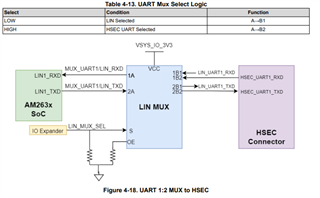Other Parts Discussed in Thread: TMDSHSECDOCK, SYSCONFIG, LP-CC2652RB
Hi,
My customer is using the TMDSCNCD263 along with the TMDSHSECDOCK to send some UART signals through the Dock's pins (SCIRX/UARTRX 76 & SCITX/UARTTX or ERRORSTS 78).
The examples in the SDK use the UART0 to send UART frames through the USB to a host PC, therefore we would like to use the UART1 to send the frames through the control card docking station.
Can you tell us describe us the best way to proceed (start from which project, configure which IO expander, how ...)
Thank you !
Geoffrey


